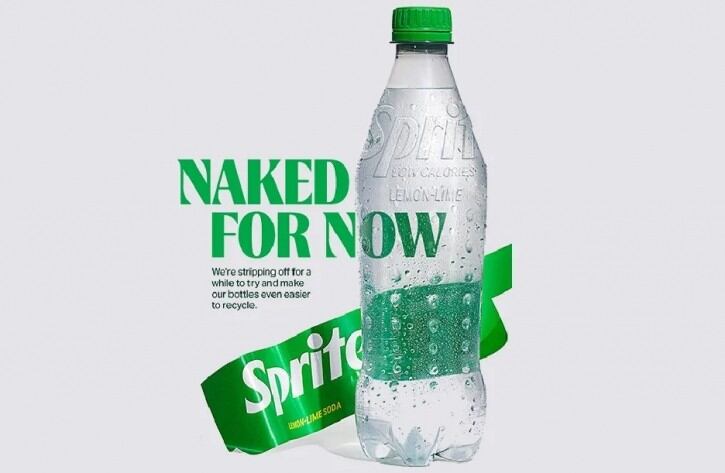Removing the label means less packaging material is used, while it also helps simplify the recycling process.
But labelling is the literal centerpiece of beverage branding. No label means very little opportunity to make a brand stand out from the crowd – or does it?
Sprite is not the first to explore removing labels – we hear what brands exploring the category have learned and the challenges that need to be overcome.
evian's pink cap bottle
Back in 2020, evian launched a label-free bottle: made from 100% recycled plastic.
“It was designed as part of evian’s journey to become a ‘circular’ brand by 2025 - making all of its plastics bottles from 100% recycled plastic (except cap and label),” explained a Danone spokesperson.
“The engraving and the ‘evian pink’ cap, specially designed for this bottle, allow the brand to have a distinctive and recognizable SKU in the market, preserving the natural beauty of the bottle and reflect what it is inside, evian natural mineral water.”
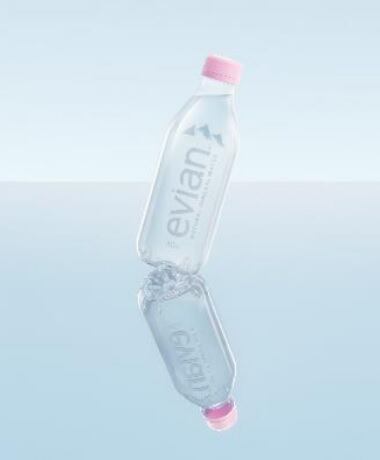
The bottle's distribution is currently limited to French hotels, restaurants and hospitality: where a key visual selling point is less important than a crowded shelf on a convenience store.
But Sprite's UK trial wants to see if label-less packaging can stand out on busy shelves in convenience stores. The trial is currently taking place in Tesco Express stores for Sprite's 500ml on-the-go format.
The bottle are relying on an embossed logo on the front of the pack and laser-engraved product information on the back, alongside with existing marketing cues such as the green cap and embossed spots.
While the move will reduce the amount of packaging used, the main aim of the UK trial is to see how consumers react to such packaging: “Although the design change may sound simple, this is a big shift from a marketing perspective,” says Coca-Cola’s VP of marketing Javier Meza.
Placing label-less bottles in stores for the first time will help the company understand how people react to the new design, and whether any further changes are needed to help people find and identify Sprite without the usual labels.
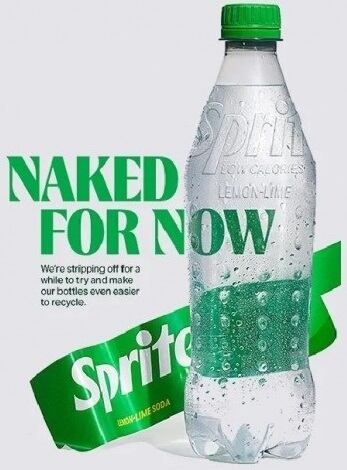
A total of eight Tesco Express stores are trialing the packaging in Brighton and Hove, Bristol, London and Manchester. Four stores are stocking label-less Sprite with accompanying point of sales materials and signage, while the remaining four stores will be stocking the label-less product with no additional marketing (an additional store in each region will act as a control).
In fact, Sprite has already trialed label-less bottles in South Korea, as has Coca‑Cola in Japan. What's new about this trial is that this is the first time the company has trialed label-less on a single-unit on-the-go 500ml bottle sold in-store (Other label-less trials have either been on multi-pack products - where labeling information was moved to the outer packaging - or, on single-unit bottles sold online - where labeling information appeared at the point of sale online).
That could be where a challenge lies. Coca-Cola HBC launched label-less bottles for its VALSER bottled water brand in 2022, as a pilot project in Switzerland sold via VALSER Service and selected online retailers.
As with Sprite, the aim of the trial has been less about quantifying environmental benefits and more about understanding consumers acceptance, said a company spokesperson.
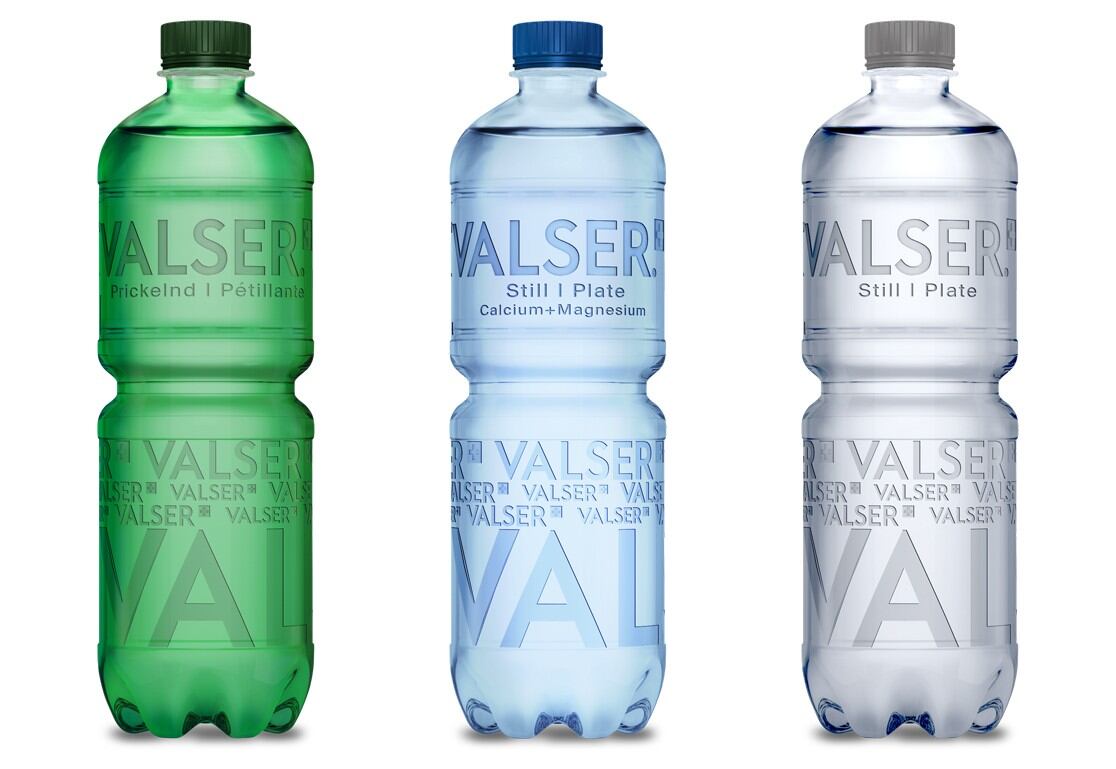
“We initiated the VALSER Labelfree pilot project in the spirit of gaining a better understanding of consumer reactions to initiatives aiming to reduce label material.
"Instead of being printed on a label, the branding and product information are embossed into the bottle. This is one of several tests of label less options.
"Our consumer study showed high product and brand recognition.”
However, the brand has found challenges in communicating the low mineral content of VALSER, which it considers a key USP.
It's decided to keep the label-free bottle on the market but in multipacks: which can be used to communicate product details (including mineral content).
Label-less wine success
The challenge for on-the-go convenience formats is capturing the attention of busy consumers. Such designs could, in fact, resonate better in higher-end beverages.
That's a category where people are willing to pay a premium, are less hassled and pressed over their shopping choices, and are also more likely to be thinking about sustainability at the point of purchase.
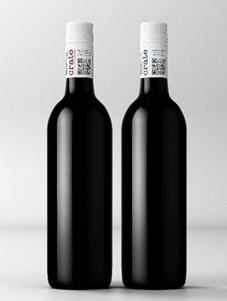
Last year, Australian wine company Fourth Wave Wines launched label-less wine, Crate.
The design does away with unsustainable branding materials and puts all the essential brand information on the tiny space of the capsule around the bottle opening.
That means no unnecessary packaging material or waste, no label printing, no adhesives and less energy used on the bottling line to remove the label component.
This capsule contains all the mandatory information, brand logotype, varietal, region, vintage, legal claims, barcode, brand messaging and QR code for further information.
The label-less design was created by drinks branding specialists Denomination. “Featuring all of the information onto the small real estate of a capsule was certainly a challenge,” said Rowena Curlewis, CEO of the agency. “However, with a careful and sensitive approach to typography, we were able to include everything without it seeming crammed. I’m delighted with the result.”
In fact, for Crate, the lack of a label creates a unique brand which encourages the consumer to take a second look on a busy shelf: plus, of course, the interest in the sustainability credentials.
“It’s a complex but interesting typographic layout which encourages the consumer to turn the bottle vertically and horizontally," said Curlewis. "If you can get consumers to do this, and physically engage with the brand, the brand recall is going to be higher.
“The sustainability angle that has been of interest to both consumers and trade. Whilst the wine itself is excellent – what was saved on the packaging went into the wine quality – it’s the disruptive view of sustainable packaging moving forward that has elicited the most conversation and interest. It’s also won a lot of design awards – both in sustainability and brand design."
Sustainability and minimalism
In the luxury arena, this idea of minimalism is already trending, according to design competition Pentawards' 2023-2024 trends report.
"One of the key trends we’ve picked up on this year is that of luxury brands minimising the use of materials in their packaging," it notes. "This can be done as a way of making product packaging more sustainable, but it also helps create a clean, minimalist appeal for higher-end products.
"This aesthetic could evoke a sense of nostalgia - harking back to the 20th century when glass bottles with embossed designs graced the shelves - while embossed lettering and visuals on glass also add rich texture."
The advent of label-less bottles - while currently limited - shows the potential of such designs.
"What I hope is that Crate will inspire other designers and marketers to think about how they can reduce physical components of packaging without losing appeal and quality credentials," says Curlewis.
Sustainability might be a key selling point in itself
Removing labels is about improving sustainability: reducing packaging materials and making it easier to recycle bottles.
Mandating label-less bottles?
Sustainability could be more than a selling point, it could ultimately become a necessity. The South Korean government is looking to mandate label-free packaging for drinking water bottles, replacing this with a digital QR code system over the next two years.
The ministry has already published detailed display standards covering characteristics such as font, character sizing, water source, types of information requires and more.
The key question, then, says Jade Horton, strategy director of Taxi Studio, is how much consumers really follow through on their sustainability aspirations. That's what marketers and brand experts need to consider.
"There is a wide range of stances on this matter, leading to questions about how much people genuinely care about brands' roles," she said. "In 2022, Statista reported that eight out of ten consumers in the UK preferred environmentally friendly packaging. Beyond preference, in 2020, McKinsey reported that 60% of people in the US stated they would be willing to pay more for sustainable packaging.
"Yet, humans are creatures of habit, and the distinction between sentiment and spending is complex, with numerous factors at play. However, one undeniable truth is that people desire sustainability."
But brands can't expect one sustainable move to create an instant win, continues Horton.
"It can't just exist as a one-off claim or be seen as a distraction to take the heat out of some unsustainable practices; instead, it needs to be a continuous journey of progress, recognizing that perfection is not the immediate expectation. It will be the sum of the parts that makes the real difference."
What's ultimately important - at least at this point - is the direction of travel. And she says marketers and branding experts will have to rise to the challenge.
"Sustainability in packaging heralds an exciting design era, as creativity thrives on constraint. This might result in removing labels altogether, like Sprite, utilizing more sustainable materials, and reducing packaging through refillable options.
"But the fundamental principles of being a brand, no matter how big or small you are, are not going to change. It's a matter of thinking differently and accepting that the rules are changing."

